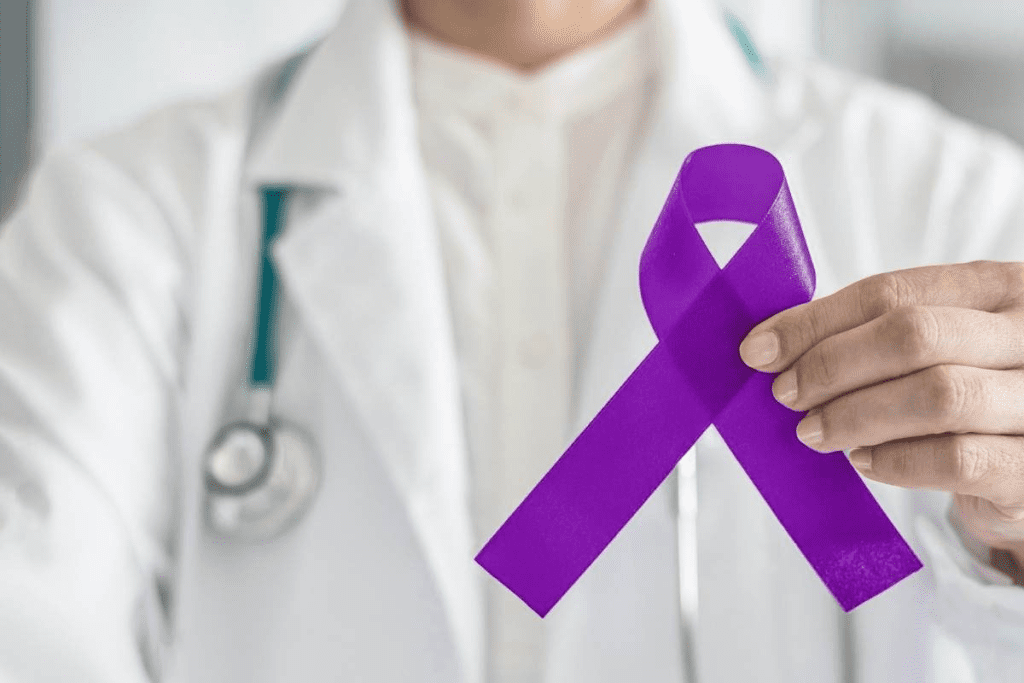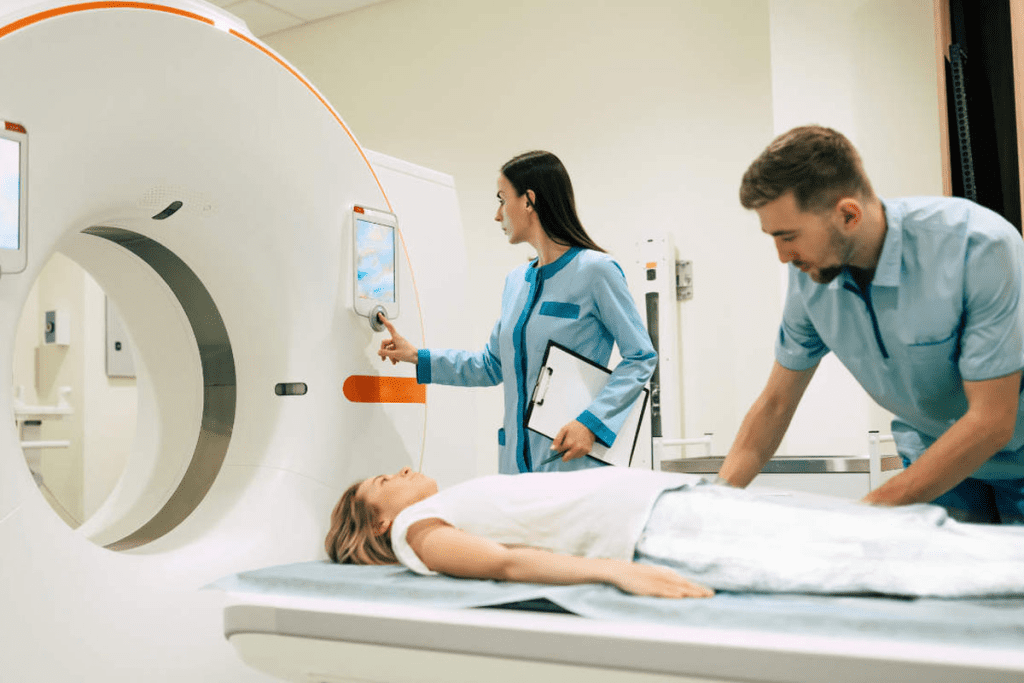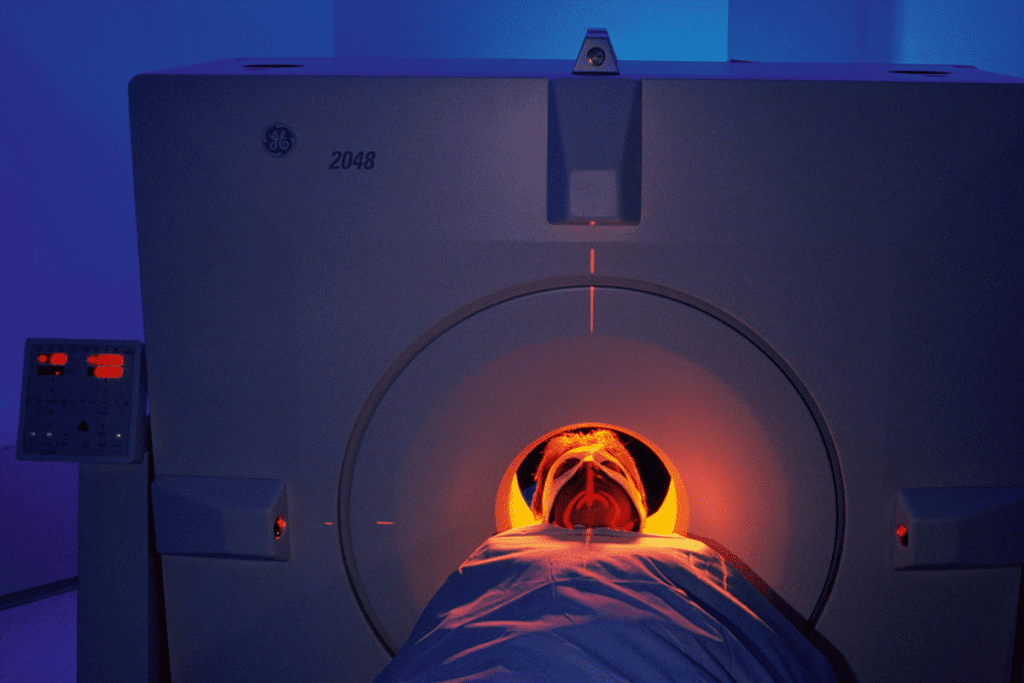Last Updated on October 22, 2025 by mcelik

Did you know over 2 million PET scans are done each year in the U.S.? They help diagnose and treat many health issues, like cancer. A PET scan is a high-tech imaging test. It shows detailed pictures of the body’s organs and tissues as they work.
The test uses a safe, injectable chemical called a radiotracer. It also needs a device called a PET scanner. Doctors often use PET scans to find cancer, check if treatments work, and see how far cancer has spread.
The size of a lung nodule on a PET scan is linked to cancer risk. Bigger nodules are more likely to be cancerous. The lung nodule size chart helps doctors quickly see this risk.
| Nodule Size (mm) | Cancer Risk | Recommended Action |
| <6 | Low | Monitoring |
| 6-10 | Moderate | Further evaluation |
| >10 | High | Biopsy or treatment |
Understanding PET scan results needs knowing both nodule size and metabolic activity. Using the lung nodule size chart and SUV values helps doctors make better decisions for patient care.

A PET scan, or Positron Emission Tomography scan, is a cutting-edge medical imaging method. It gives deep insights into the body’s metabolic processes. It’s great for diagnosing and managing diseases like cancer, neurological disorders, and heart disease.
The process starts with a radioactive tracer being injected into the patient’s blood. This tracer is usually a glucose molecule with a radioactive atom. It goes to areas with high activity, like growing cancer cells.
PET imaging detects photons from the radioactive tracer. The PET scanner captures these photons. It then makes detailed images of the body’s internal structures and functions.
The most used tracer is Fluorodeoxyglucose (FDG). It’s a glucose analog that cells take up based on their glucose use. Cancer cells, with their high metabolism, take up more FDG. This makes them visible on PET scans.
PET scans rely on glucose metabolism to detect cancer. This is because cancer cells use more glucose. This makes it easier to spot cancer early and track how well treatments are working.
| Aspect | Description | Benefit |
| Radioactive Tracer | Glucose molecule attached to a radioactive atom | Highlights areas of high metabolic activity |
| PET Imaging | Detects photons emitted by the tracer | Creates detailed images of body functions |
| Glucose Metabolism | Cells absorb tracer based on metabolic rate | Identifies cancerous tissues effectively |
Understanding PET scans helps patients and doctors see their value. This is true, even more so for lung cancer.

PET scans are key in finding many health issues, like cancer and brain problems. They show how the body works, helping find diseases early and track them.
PET scans are mainly used to find and check cancer. They spot areas where cells are very active, showing where cancer is. This helps doctors plan the best treatment. For example, a pet scan for lungs can spot lung cancer and see if it has spread.
PET scans are also great for checking brain diseases, like Alzheimer’s and Parkinson’s. They find where brain activity is low, helping doctors understand and treat these diseases.
PET scans help with heart disease too. They check if heart tissue is working well and find where blood flow is low. This helps doctors treat heart problems better.
PET scans are very important in finding and managing serious health issues. They are a key part of modern medicine.
PET scans have changed the game in lung cancer diagnosis. PET scans for lung cancer are now key for doctors. They help find the disease early and accurately.
PET scans are great for catching lung cancer early. They spot cancer by showing where glucose levels are high. This is key for planning treatment.
After finding lung cancer, PET scans help figure out how far it has spread. This info helps doctors choose the best treatment. It could be surgery, chemo, or radiation.
Lung cancer PET scans also track how well treatment works. By comparing scans, doctors see if the treatment is effective. They can then adjust the plan if needed.
PET scans have greatly improved lung cancer care. They help find cancer early, accurately stage it, and monitor treatment. This makes a big difference in patient outcomes.
PET scans give detailed images of lung nodules. This info is key for diagnosing and managing lung conditions. It helps understand the nature of lung nodules found during scans.
Lung nodules are measured by their diameter. PET scans assess their characteristics. The size of a nodule can show if it might be cancerous.
Nodules are sorted into categories based on size. This helps doctors figure out the risk and what to do next. For example, small nodules are seen as low risk, while larger ones are considered higher risk.
The Standardized Uptake Value (SUV) shows how active a nodule is. It compares the glucose uptake of the nodule to the surrounding tissue. A high SUV value means the nodule is very active, which could be a sign of cancer.
SUV values are key for telling apart benign and possibly cancerous nodules. If the SUV is high, it might mean cancer, leading to more tests or a biopsy.
Getting ready for a PET scan is important for good results. You need to make dietary changes, adjust your medications, and know what to bring. This helps the scan go well.
Your doctor will tell you what to eat before the scan. Usually, you need to fast for 4-6 hours before it. Avoid sugary foods and drinks for 24 hours to help the scan work better.
They might ask you to eat less carbs a day or two before. Drinking water is good, but follow your doctor’s advice on this.
Some medicines can change how the PET scan works. Tell your doctor about all your medicines. They might ask you to stop or change some before the scan.
Wear comfy clothes without metal on the day of the scan. Bring your doctor’s referral and insurance info. Also, take your medicines and any important medical history.
By following these steps, your PET scan will be successful. This ensures the best possible results.
Learning about the PET scan procedure can ease anxiety for those about to undergo it. The process includes several important steps to get accurate results.
When you arrive at the scanning facility, you’ll need to fill out paperwork. You might also have to change into a hospital gown. It’s important to follow any dietary restrictions or other preparation instructions given by the staff.
Remember to tell your healthcare provider about any medications you’re taking. Some might need to be adjusted or avoided before the scan. Wear loose, comfortable clothing to stay comfortable during the procedure.
The next step is getting an injection of a radioactive tracer into your arm. This tracer is a special form of glucose that goes to areas with high activity, like cancer cells. After the injection, you’ll wait about 60 minutes for the tracer to be absorbed by your body.
“The use of radioactive tracers in PET scans has revolutionized the field of diagnostic imaging, enabling healthcare professionals to assess metabolic activity within the body.”
After the tracer is absorbed, you’ll lie on a scanning table that moves into the PET scanner. The scan is usually painless and can last from a few minutes to an hour. This depends on the type of scan and the body area being scanned.
It’s important to stay very quiet and not move during the scan. The PET scanner picks up signals from the tracer, making detailed images. These images help doctors diagnose and monitor different health conditions.
By knowing the PET scan procedure, patients can prepare better. This reduces anxiety and makes the experience smoother.
The use of PET and CT scans together is a big step forward in fighting lung cancer. It mixes the detailed metabolic info from PET scans with the detailed body images from CT scans. This gives doctors a clearer picture of the disease.
PET scans show where in the body cancer cells are by looking at how much glucose they use. CT scans, on the other hand, give detailed pictures of the body’s structures. Together, PET-CT scans help doctors find and check the activity of tumors more accurately.
Benefits of PET-CT Combination:
The PET-CT combo is great for checking lung nodules and figuring out how far lung cancer has spread. It helps doctors plan the best treatment for each patient.
| Diagnostic Modality | Information Provided | Clinical Utility |
| PET Scan | Metabolic activity | Cancer detection, treatment response |
| CT Scan | Anatomical details | Structural assessment, tumor localization |
| PET-CT Combination | Both metabolic and anatomical information | Accurate diagnosis, staging, and treatment planning |
The PET-CT scan makes diagnosing and figuring out how far lung cancer has spread more accurate. This leads to better treatment plans and outcomes for patients.
Lung imaging techniques vary. It’s important to know the differences between PET scans, CT scans, and MRI for accurate diagnosis.
PET scans and CT scans are both useful for diagnosis. But they do different things. CT scans show detailed anatomy, while PET scans look at metabolic activity.
They differ in detecting lung nodules. CT scans spot nodules by size and shape. But PET scans check if these nodules are active, helping tell if they’re cancerous.
| Imaging Technique | Primary Use | Strengths |
| PET Scan | Metabolic activity assessment | Detects functional changes, cancer staging |
| CT Scan | Anatomical imaging | High-resolution images, nodule detection |
| MRI | Soft tissue evaluation | No radiation, detailed soft tissue imaging |
MRI isn’t usually the first pick for lung checks. But it’s good for looking at soft tissues and checking lymph nodes.
PET scans are better for finding cancer spread and checking tumor activity. They’re key for cancer staging and treatment tracking.
Doctors often pick PET scans for lung nodule or tumor activity checks. This is key for cancer staging and treatment monitoring.
PET scans are great for spotting lung changes. They’re vital for lung cancer diagnosis and care.
PET scanning is getting better, opening up new ways to diagnose diseases. It’s becoming more important in finding and treating different health issues.
Research is pushing PET scanning forward, making it more accurate and useful. It’s now used to spot and track diseases like cancer, brain problems, and heart issues.
PET scans show how tissues work, making them key in medical diagnosis. As health care gets better, PET scans will help doctors make smarter choices for patients.
PET scans are playing a bigger role in health care, showing their value. With ongoing tech improvements, we can expect even better ways to diagnose and treat diseases.
A PET scan helps find many health issues. This includes cancer, brain problems, and heart diseases. It spots changes in how the body uses energy.
A PET scan uses a special dye that lights up in areas that are very active. The scanner picks up this light. It makes pictures of how active different parts of the body are.
Glucose metabolism is key in PET scans. Cancer cells use more glucose than normal cells. So, the scan can spot cancer by seeing where glucose is used more.
To get ready for a PET scan, you might need to eat less or avoid some medicines. You should also wear loose clothes. Your doctor will tell you exactly what to do.
The PET scan process starts with a dye injection. Then, you wait for it to spread. After that, you lie on a table that slides into the scanner. The whole scan takes about 30-60 minutes.
Doctors study the images from the PET scan to find any unusual activity. This can show if there’s cancer or other problems.
SUV values show how much dye is taken up by an area. High values mean there might be cancer. Doctors use these values to understand how serious the problem is.
Yes, PET scans can find lung cancer, even better when used with CT scans. They help doctors see where the cancer is, how big it is, and if treatment is working.
Using both PET and CT scans gives a clearer picture of lung cancer. The PET scan shows where the body is most active, while the CT scan shows the body’s structure. Together, they help doctors diagnose and plan treatment better.
Subscribe to our e-newsletter to stay informed about the latest innovations in the world of health and exclusive offers!